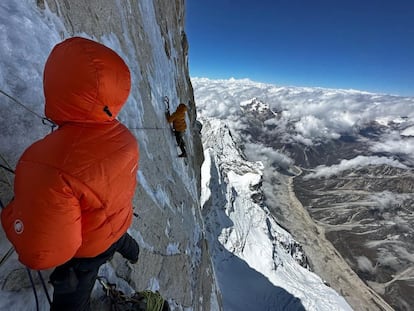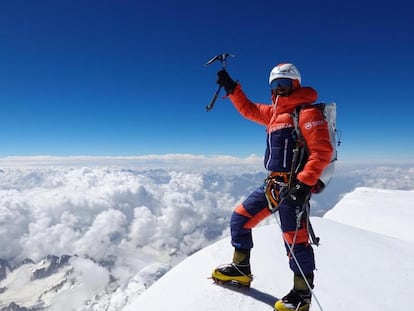Kazuya Hiraide: ‘I have climbed many mountains, and now I have become afraid of them’
The Japanese mountaineer, one of the most celebrated climbers of the 21st century, stars in a new documentary with his partner Kenro Nakajima, which documents the first alpine ascent of the north face of Tirich Mir
Two men, two backpacks, a virgin Himalayan wall, a rope that connects everything and the honesty captured in two tiny cameras attached to the side of the helmet. With so little, the audience that flocked to Bilbao’s BBK MendiFilm in Spain on Saturday, one of the most prestigious mountaineering film festivals in existence, was treated to the documentary Rope, a superb dissection of what it means to be an elite mountaineer. Or of what an elite mountaineer can hide within themselves. The film, a work of pure and delightful craftsmanship, documents the first successful alpine-style ascent of the north face of Tirich Mir, a 7,708-meter peak in Pakistan, by Kazuya Hiraide and Kenro Nakajima last July. Together they have twice won the Piolet D’Or, the Oscar of the mountaineering world. Hiraide has three altogether with the one he obtained together with the late Kei Taniguchi, the first woman to win the award.
The northern slope of Tirich Mir is so remote that it demanded a huge amount of exploration from the Japanese climbers: just reaching the foot of the target required a search among walls and glaciers until they found a way to get into position. In the summer, very few details were revealed. Ternua, Hiraide’s Basque sponsor, could only offer a handful of photos and a brief text. Nothing to illuminate the sheer guts behind an ascent involving so much commitment, nothing that would allow us to know a little more about one of the most effective partnerships in the history of Himalayan mountaineering. The documentary happily resolves this with a handful of memorable phrases and images that make you feel as if you are tied to one end of the rope. Without context, mountaineering is a gibberish of numbers, an athletic exercise without soul. Well explained, it is an art; the art of trust, of teamwork, of respect and ethics, of the simplest happiness, of childlike excitement, of the search for undiscovered worlds.
Hiraide is 44 and admits to having discovered fear after more than 20 years in the elite sport. “I have climbed many mountains, and now I have become afraid of them. They scare me because now I know the danger under my feet. When I head for a mountain, fear makes me hesitate, it’s hard for me to take the step, but Kenro does it without a second’s hesitation. I have lost that innocence. His courage is the reason I am able to climb these mountains,” he explains to the camera. What more can be said? Hiraide says it all, thus explaining his journey from bravery to the heavy shadow of doubt, from fierce leadership to humility, from the need to climb to the need to do so tied to an equal, even to subordinate himself to his abilities. The great climbers of the past — Walter Bonatti for example — always climbed in the lead, took the risks, led the team, and only asked for a good partner, someone who knew how to handle the ropes, hold his own during discussions and provide encouragement when the going got tough. Hiraide was like that. But now he needs help. He needs a leader by his side… and he’s waiting for Kenro Nakajima to take over. But first he has to trust him. The psychological study of the dynamics that are established in the heart of a rope team could be the subject of several books. These are marriages, but ones where live is at stake. “I don’t like to climb alone. If I were alone, I would fall. I have a better chance of climbing mountains if I’m tied to someone else,” says Hiraide.
Nakajima is 10 years younger than Hiraide, and he still can’t believe they are climbing hand in hand. After Taniguchi’s death, Hiraide was slow to find a replacement: trust is not earned overnight, and the loss of his partner plunged him into a pit of skepticism. He became convinced that it would be impossible for him to find an alter ego again. For his part, Nakajima admired Hiraide so much that he saw him as unattainable: “It’s rare to climb feeling 100% safe roped to each other. I’m surprised he’s my partner. He’s my mentor,” he explains in the documentary. Hiraide reprimands his friend when he gets his rope tangled in an abseil (“you can’t be lazy here”) or when he insists on advancing along the same line where an avalanche is falling. And when he hesitates and asks for advice, stuck on the wall and unsure which way to go. Hiraide forces him to make a decision: “Believe in yourself and move forward, you must think like that, okay? Or you’ll never know if you can make it. He still waits for my advice and my presence. I want him to believe in himself and go first,” Hiraide explains in the middle of the climb. In the next shot, the camera focuses on Kenro’s ice axes and picks up his voice: “Because Hiraide was with me, I always asked him to make the decisions. I have to learn to be more independent.” What distinguishes a leader in the world of mountaineering is his ability to always make the best decision in any eventuality. And this has nothing to do with bicep size or aerobic capacity, but with knowledge of the environment, instinct, and experience.
Very close to the summit, both climbers progress together on the rope, separated by a few meters. The terrain is not technical, but it is very steep and the snow on which they are moving does not allow for intermediate belays. If one were to fall, both would die. The fear of failing, of not seeing the summit, of suffering an accident, suddenly assaults Hiraide. The gasps are perfectly audible on the recording, but then Hiraide asks Nakajima, who has climbed the entire route first: “This is very vertical: won’t you fall?” Nakajima freaks out, hesitates, looks to his side, looks down at his partner, and after a few moments tells him that he won’t fall. Hiraide bursts with joy, as if his friend had deciphered a riddle, and replies: “I expected nothing less from you. That’s why we climb together. I know this is hard, but concentrate.”
The summit is flat, wide, and the mountains crowd around them everywhere. It is a bright day. Nakajima thanks Hiraide, cries, and Hiraide thanks him back. Thanks to his young friend, he has been able to reach a place that, he admits, he would never have achieved alone. Mountaineering is an activity conditioned by the fear of losing one’s life, a fear that sows doubts, that destroys careers, that imposes limitations… but one that is fought in company. By means of a rope.
Sign up for our weekly newsletter to get more English-language news coverage from EL PAÍS USA Edition
Tu suscripción se está usando en otro dispositivo
¿Quieres añadir otro usuario a tu suscripción?
Si continúas leyendo en este dispositivo, no se podrá leer en el otro.
FlechaTu suscripción se está usando en otro dispositivo y solo puedes acceder a EL PAÍS desde un dispositivo a la vez.
Si quieres compartir tu cuenta, cambia tu suscripción a la modalidad Premium, así podrás añadir otro usuario. Cada uno accederá con su propia cuenta de email, lo que os permitirá personalizar vuestra experiencia en EL PAÍS.
¿Tienes una suscripción de empresa? Accede aquí para contratar más cuentas.
En el caso de no saber quién está usando tu cuenta, te recomendamos cambiar tu contraseña aquí.
Si decides continuar compartiendo tu cuenta, este mensaje se mostrará en tu dispositivo y en el de la otra persona que está usando tu cuenta de forma indefinida, afectando a tu experiencia de lectura. Puedes consultar aquí los términos y condiciones de la suscripción digital.
More information
Archived In
Últimas noticias
The complicated life of Francesca Albanese: A rising figure in Italy but barred from every bank by Trump’s sanctions
How Japan is trying to avert ‘digital defeat’
Half of Scotland is in the hands of 420 property owners
Reinhard Genzel, Nobel laureate in physics: ‘One-minute videos will never give you the truth’
Most viewed
- Pablo Escobar’s hippos: A serious environmental problem, 40 years on
- Reinhard Genzel, Nobel laureate in physics: ‘One-minute videos will never give you the truth’
- Why we lost the habit of sleeping in two segments and how that changed our sense of time
- Charles Dubouloz, mountaineering star, retires at 36 with a farewell tour inspired by Walter Bonatti
- The Florida Keys tourist paradise is besieged by immigration agents: ‘We’ve never seen anything like this’











































